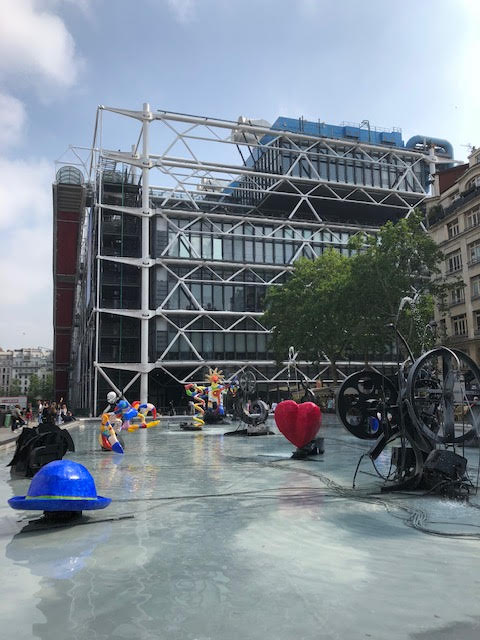Transformation Process–the process of transforming raw material into a finished good.
The Centre Georges Pompidou is an architectural anomaly in the heart of the charming Beaubourg district. Nothing about this structure says “museum,” which is part of the point of the place. This machine sits, plunked down or assembled (depending on your point of view), in the 4th Arrondissement of Paris. This is the same part of the city that cradles Notre Dame, that magnificent Gothic cathedral, also in the business of its own type transformation.
I visited the Pompidou, the day after an immersive experience at Monet’s masterpiece–Giverny. As I rounded the corner at Rue Saint-Merri and followed the expansive sloping plaza to the entrance of this machine/museum, my first response was,
“Ick.”
I felt like I was about to go on a manufacturing plant tour rather than another immersive art experience. Gone were the contemplative willows, bamboo, bridges and water lilies of Giverny. The Pompidou offered me up a steely exo-skeleton, with tubes of arteries exposed, in a stark rectangular block.
Giverny, invited me into a world. Pompidou dared me to deal with it.
I allowed this mechanism to carry me through its common input conveyor into the heart of its machinery. As a space, it let me off the hook a bit, lulling me into the safe and familiar images of Picasso, Mirot, and Matisse, so comfortable in our age, but so revolutionary when created. It even allowed me a few sips of champagne on the terrace.
But this machinery was only prepping me for the onslaught of the next step on the line, where I was pounded, forged, bent and hammered by an onslaught of provocative and evocative contemporary work that challenged the very assumptions I held about what art actually is.
After walking through Jean Debuffet’s “Hive” I reconsider what a landscape piece really is, or could be, or ever was to begin with.
After initially being offended by Niki de Saint Phille’s “Le Mariee,” I have to reconsider the role of women and must reinvent what marriage should mean, rather than what it has meant.
And on and on it goes, gallery after gallery, space after space, challenge, after challenge, after challenge.
Then, just like that, the Pompidou spits me out into the blank floor of its western plaza.
“Vous avez termine’.”
Maybe.
The Pompidou may have been finished with me, but I was not done with it. I needed time to process the experience of my own mental transformations.
On the long plane ride home, I was considering a new poem, which is a pretty normal thing for me, then a new type of questioning popped into my head.
Why does a poem need to be on a flat piece of paper with lines that read top to bottom and left to right?
Is it possible for a poem to exist in multi-dimensional space?
Can a poem be visual and transcend its place in font and typography?
At 32,000 feet somewhere south of Greenland over the Atlantic Ocean, I understood the transformation process that the Pompidou inflicted on me, to see differently, to hear, and speak, and write differently, to push the boundaries beyond anything even reasonable, to be transformed in order to transform.
Back home, I pull up PowerPoint and begin playing with cut and pasting poetic lines alongside images layered with narration in a form I have dubbed a “slider.” I imagine, later that night, that I can hear it, that giant machine across the sea, chugging and puffing, accelerating production, transforming its raw materials into the very form of awareness.
